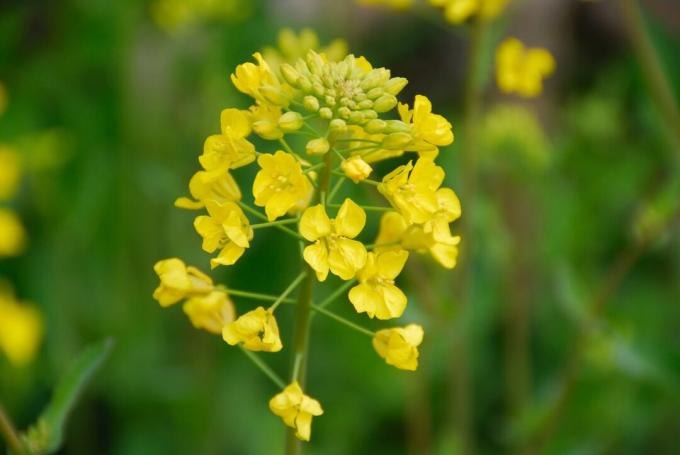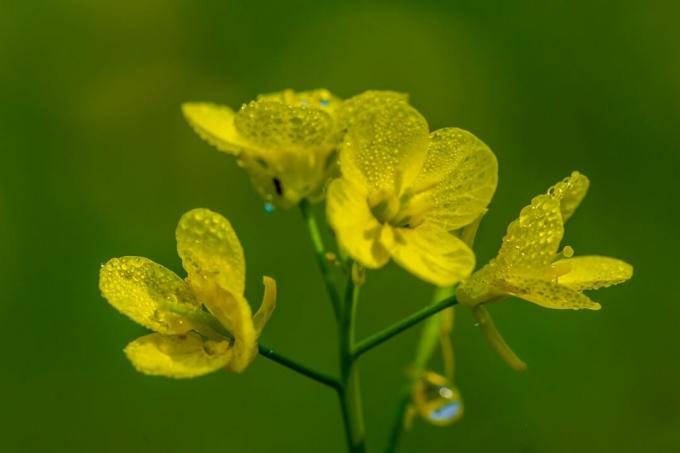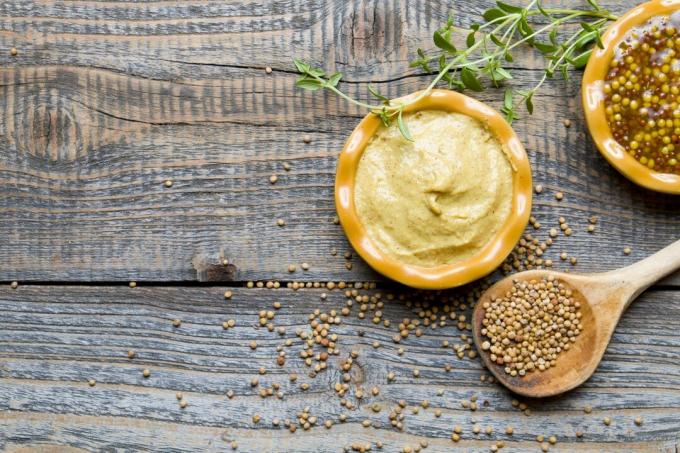Most of the time you see mustard grown in large fields, but it can also be very decorative and useful in your own garden. You can find out here which types of mustard there are and how to care for the mustard.

Mustard has a long history, having been used as a spice for thousands of years and also as a medicinal plant in the Middle Ages. Today it is becoming increasingly popular in domestic gardens. This article provides an overview of different types of mustard, how mustard is grown in the garden and how you can use mustard seeds.
contents
- Mustard plant: origin and properties
- Types and varieties of mustard
- Cultivating mustard in the garden
- Harvesting mustard: timing and procedure
- Storing and preserving mustard
- ingredients of mustard
- Common Mustard Pests
Mustard plant: origin and properties
When the fields bloom yellow in autumn, the popular mustard grows there. We mainly use white and brown mustard (Sinapis alba and Brassicajuncea) cultivated, the black mustard (
Brassica nigra), on the other hand, is hardly cultivated agriculturally because of the difficulty of mechanical harvesting. From a strictly botanical point of view, brown and black mustard are not “real” mustard at all, because both plants do not belong to the mustard genus (Sinapis) at.The pretty-looking yellow mustard flowers resemble those of the canola confusingly similar. Both plants belong to the cruciferous family (Brassicaceae), but differ in flowering time, smell and use. If the mustard is sown in May or pre-germinated on the windowsill from February, it will bloom between June and September and can be used as a decorative flower.

The origin of mustard is probably India. During excavations, remains of cultivations were found there, which date from around 1800 BC. Chr. come. On the European continent, mustard was first used in a mustard paste recipe dating back to ancient Rome around 100 AD. Chr. mentioned. Along with horseradish, mustard is the first hot spice in Europe and even older than pepper and chili. In the Middle Ages, black mustard in particular was said to have a healing effect: it was said to promote blood circulation, calm pain and have an anti-inflammatory effect.
But what does the mustard plant look like? The white mustard grows 30 to 70 cm high, the brown one 120 cm, while the black mustard can reach a height of 200 cm. What is striking about the annual herb is the angular stem that branches out at the top and forms rough leaves. In addition, the mustard leaves are divided into a petiole and an ovate leaf blade (this is the leaf surface). The edge is usually smooth to slightly serrated. The mustard blossom develops four petals and six stamens - there is hardly any visual difference between the blossoms of rapeseed and mustard. The main distinguishing feature is therefore the flowering time: while oilseed rape flowers in spring, mustard flowers can only be seen in late summer to autumn.

The mustard flowers are hermaphroditic and can pollinate themselves, so they do not need another plant as a pollen donor. Pollination occurs either by wind movement or by insects, which like to visit the flower. Mustard forms a deep-reaching root system, which is why it is well suited for loosening soil, as a catch crop or as green manure. The seeds are formed in pods and are about the size of a pea. You can either use them whole, grind them into a powder or use them to make the famous condiment paste, the table mustard.
Types and varieties of mustard
In general, a distinction is made between white, brown and black mustard:
- White Mustard (Sinapis alba): Also called yellow mustard because of the intense yellow flowers. It forms 4 to 8 seeds per pod, the seeds are white to light yellow with a mild taste.
- Brown Mustard (Brassicajuncea): Also known as Indian or Chinese mustard. It forms 6 to 15 seeds per pod, which are dark to light brown. The use of mustard oil is still common in Asia, but it has been replaced by rapeseed because of the low yield. Brown mustard is mainly used in Dijon mustard. He has a sharp taste. An interesting variety is 'Rouge Métis', which has a slit, red-purple leaf and is therefore particularly decorative in salads. And the 'Southern Giant Curled' variety, the Krause mustard, is also highly recommended: It forms very large leaves that can be used in salads, on bread or cooked like spinach.
- Black Mustard (Brassica nigra): Rarely referred to as mustard cabbage. It forms 4 to 10 seeds per pod, which are dark brown or gray to black in color. What is striking is a mostly hairy, black stem that turns blue towards the top. Black mustard is not grown commercially because the pods are very close to the stalk and therefore cannot be easily harvested by machine. He has a sharp taste.

Cultivating mustard in the garden
Who in their own garden plant mustard would like requires a sunny or at least partially shaded location. A humus rich, calcareous soil is preferred for growth. The cultivation of mustard is possible in mixed cultivation with almost all other types of vegetables, only other cruciferous plants such as cauliflower(Brassica oleracea var. botrytis) or broccoli (Brassica oleracea var. italiana) should be avoided. In addition, it is important that a plant of the family does not return at the earliest after four years Brassicaceae grown at the same location, otherwise diseases can be transmitted.
Mustard is a very undemanding plant during vegetation. If it is grown in a well-nourished location, regular watering will suffice. If you use mustard as a catch crop or to improve the soil structure, this usually happens on less good locations.
Here it is recommended to supply the plants with additional nutrients in the form of fertilization. This allows them to develop their full power and improve the soil. Additional fertilization of the mustard in a poor location ensures that it grows better, the nutrients stored in all its plant organs and releases them again when they rot on the compost or directly on the bed gives. Due to the good growth of the mustard plants, carbon is fixed and can be used as humus after rotting.
For example, our primarily organic fertilizer is suitable as a fertilizer Plantura organic universal fertilizer. This not only provides the plant with ideal nutrients, but also supports active soil life. Since mustard is an annual plant, it dies back in the fall and is therefore not hardy. If the ripe seeds are not harvested, they will naturally sprout again the following year.
Harvesting mustard: timing and procedure
The first leaves can be harvested just three weeks after germination. These taste delicious as an addition to a fresh salad. In Indian cuisine, spinach-like vegetables are often cooked from the mustard greens. As the leaves get older, they become bitter and no longer taste as good. As soon as the mustard begins to flower, you should completely avoid harvesting the leaves. In this way, the plant can put all its energy into the formation of flowers and pods and does not have to develop new leaves.
The mustard pods are ready to harvest as soon as they are dry. This usually happens in September or October. If the pods rattle when you shake them, they are dry enough. They can be easily removed from the plant by hand, then they have to be opened and the grains removed. With a large crop, it's easier to place the collected pods in a bag and tap them with your hand or a rolling pin to loosen the mustard seeds. These can then be easily picked out.

Storing and preserving mustard
The harvested mustard seeds can then be dried. It is enough to put them on a piece of newspaper and leave them at room temperature and with good ventilation for about four weeks. If you put the newspaper with the mustard seeds on the heater, it will dry even faster. The grains can then be stored whole in a dark, dry place or ground into mustard flour. They are then suitable as an addition to pickled vegetables such as pickles or as a spice for meat and vegetables. As an alternative to drying, the mustard seeds can also be processed directly into mustard paste.
ingredients of mustard
Already in the Middle Ages, mustard was considered medicinal plant, which is mainly due to its ingredients. The different varieties consist of about 20-30 percent mustard oil, which contains many healthy, unsaturated fatty acids. Mustard also contains a high proportion of protein (about 28 percent). The glycosides it contains are responsible for the spiciness of the mustard. These differ in white and brown, or black mustard. However, the pungent taste only develops when the glycosides are broken down and react with an enzyme. Therefore, when you chew a mustard seed, it tastes sweet and nutty at first and becomes spicy after a while.

Common Mustard Pests
Mustard is a very robust plant and hardly has to deal with pests. However, like other cruciferous vegetables, they can with dryness flea beetles become problematic. However, as a preventive measure, it helps to remove weeds early, to water the plants regularly and to keep the soil permanently moist with a layer of mulch.
the white bow tie, also known as the greenhouse whitefly, can be easily suppressed with beneficial insects. It is enough to make the garden attractive for beneficial insects, for example with insect hotels and a flower meadow. This not only helps the mustard, but your entire garden.
As already mentioned, mustard is ideal as a green manure. In an article we have helpful tips and other options green manure in autumn compiled for you.



